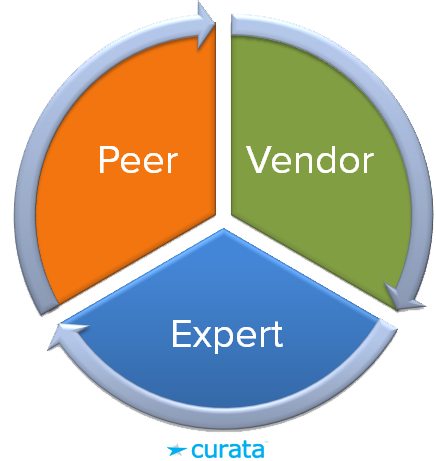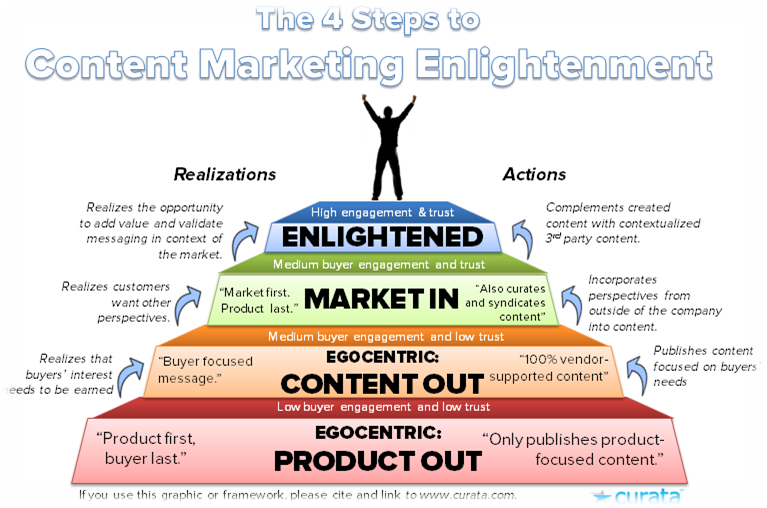- Share The Sales Lion Needs to Come Out of His Den on Facebook
- Share The Sales Lion Needs to Come Out of His Den on Twitter
- Share The Sales Lion Needs to Come Out of His Den on Linkedin
- Share The Sales Lion Needs to Come Out of His Den via email
Last week, speaker, marketer and author of Inbound and Content Marketing Made Easy, Marcus Sheridan, the self-acclaimed “The Sales Lion” wrote a controversial blog post “Why Curated Content on Your Website is an Ineffective Waste of Time”.
Sheridan demonstrates a lack of understanding of what curation really is, and furthermore, he is confused by how it benefits marketers. Instead, he advocates for solely creating content, and not curating other people’s content.
Here are areas where the Sales Lion is just flat wrong.
Content Curation can establish you as a Trusted Source
Sheridan comes from the world view that your marketing must be all about me, me, me. Your content marketing must be only your voice, focused on only your brand. In his post, Sheridan asks a series of rhetorical questions, that are actually very easy to answer:
“But when your website consists mainly of articles from other sites, how in the world will that establish YOUR company as the trusted and expert voice at what you do?”
In the buying cycle, buyers make a decision by consuming three types of content: Peer content (produced by other buyers), Expert content (produced by third-party subject matter experts like trade publications and analysts) and lastly, vendor content (the content that you produce as a part of your own content marketing).
Marcus is is saying that as a content marketer, you should only provide your buyers with your vendor content. There are a few issues with this:
- Buyers trust vendor content the least. Vendor content is normally seen as partisan, biased even when created with the end buyer in mind.
- Buyers will go elsewhere for expert and peer content. Left to their own accord, buyers will go find other resources online for a fuller, more comprehensive understanding. They may search on Google, or find other subject matter sites.
Marcus’s thought process goes something like this: Once buyers come to your site, they will not go anywhere else before making a purchase. Therefore, it’s only a marketer’s loss to profusely link to third party off-site content. Linking to third party content can only hurt conversion rates and will drive people away from your brand. Therefore curation is an “ineffective waste”.
But the foundation of his argument is flawed. Unless you are selling a low consideration, commoditized consumer purchase like a phone calling card, once buyers come to your site, they will go elsewhere as part of the purchase process. They will visit other vendor sites. They will read reviews by other buyers. They will search online to see what experts think. This whole process, in fact, may take weeks or months depending on how high consideration of the purchase is.
By carefully and regularly curating content from around the web, you can establish yourself as a trusted and expert starting point for your buyer’s online journey as it pertains to your topic area. Read more about this area at STOP Egocentric Marketing.
Content Curation can help you generate leads
Next in Sheridan’s article he asks a few other rhetorical questions to cast doubt on curation:
“How will it generate leads? How will it help you earn new customers?”
But the answers are quite simple as to how curation can help generate leads and customers. As you become a trusted authority, by being an information resource for your buyers, they become not just leads but high quality leads.
Here’s how it usually works:
-
A good content curator, who regularly publishes content on a specific topic, becomes a reliable, reputable and comprehensive source of information. For real world examples, see the Content Curation Lookbook.
-
A loyal and dedicated audience begins to rely on the curation as a vital source of information.
-
In order to stay on top of the curated content, the audience subscribes to the curator either by joining an email newsletter list, subscribing to an RSS feed, or following the curator on a social media channel. You can read more about why subscription metrics are so important for curator.
-
Now that the curator has their audience’s attention, the curator can draw them closer to their brand through mid-funnel content, or even more aggressively by entering their email address into a marketing automation lead nurture program.
Not only does this work extremely well in terms of lead quantity, but it greatly improves the lead quality as well. Why? Because individuals who come in through curated content are genuinely interested; and over time they become genuinely educated about your topic by being exposed to relevant content. Here’s a recent case study in Marketing Sherpa about how one company increased their list size and lead quality solely through curation.
Curation can Lead to Conversions
Marcus’s next criticism of curation goes as follows:
“Furthermore, can you imagine anyone ever saying, ‘I came to your site and I loved everyone else’s content so much that I decided to do business with you…’?”
Yes, I can not only imagine this, but I have seen companies win business through curated content. Tooting your own horn through your own content is not optimal — it’s egocentric and not credible to a buyer. Contrast that with a curated approach where your original content is juxtapositioned with third party content that validates your point of view. If an analyst, or a trade publication has the same perspective as you, that makes you all the more credible — and can lead buyers to do business with you. Your audience will appreciate the value of differing perspectives, the curated content can support your own marketing message, and you will be in a better position to support a strong supply of content on a regular basis at a reduced cost.
For further reading, here’s a whole eBook The Open and Shut Case for Content Curation with the benefits and ROI of curation.
Google likes Content Curation
Sheridan tries to create some FUD (Fear, Uncertainty, Doubt) about curation by citing a Google video about webspam content violations.
But the video is completely out of context. The video never talks about curated content. Instead it talks about syndicated content. There’s a very large distinction between the two that Marcus fails to understand.
-
Aggregated and syndicated content — typically done through automated means is shunned by Google because it adds little value to the end reader and is often irrelevant to the topic at hand.
- Curated content is valued by Google if done right. A good curator is selective about what she or he publishes. A good curator doesn’t just copy and paste, they also add annotation and commentary. And a good curator is ethical and doesn’t use the full text of the original content.
In fact, just a few months ago, Google’s own SEO guru, Matt Cutts created a video where he explicitly extols curation and its value, while simultaneously chastising aggregated content.
Why the Sales Lion Needs to Come out of His Den
I recently published a blog post about the 4 Steps to Content Marketing Enlightenment (you can see the gist of it in the graphic below).
The Sales Lion is on step two right now, the Egocentric: Content Out marketing strategy. He has done a great job educating and inspiring many marketers (including myself) about the virtues of content marketing through his own amazing success selling fiberglass pools. He encourages marketers to create content that’s focused on the buyer, by polling sources like your sales team, or looking at your search analytics for questions that your audience may have.
But beyond that, he’s falling short. Enlightened marketers realize that while buyer inquiries need to be answered by your brand, your buyers will ultimately look for answers to those same questions from other market perspectives as well. If you can bring those points of view into your own content, into your own site, and incorporate them into your own voice, you will help guide your buyers.
The only way to do that is by coming out of your own den, recognizing that you’re not the only one with a valid viewpoint, and curating others’ voices as well.











